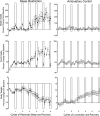Recurrent restriction of sleep and inadequate recuperation induce both adaptive changes and pathological outcomes
- PMID: 19692662
- PMCID: PMC2777777
- DOI: 10.1152/ajpregu.00230.2009
Recurrent restriction of sleep and inadequate recuperation induce both adaptive changes and pathological outcomes
Abstract
Chronic restriction of a basic biological need induces adaptations to help meet requisites for survival. The adaptations to chronic restriction of sleep are unknown. A single episode of 10 days of partial sleep loss in rats previously was shown to be tolerated and to result in increased food intake and loss of body weight as principal signs. The purpose of the present experiment was to investigate the extent to which adaptation to chronic sleep restriction would ameliorate short-term effects and result in a changed internal phenotype. Rats were studied during 10 wk of multiple periods of restricted and unrestricted sleep to allow adaptive changes to develop. Control rats received the same ambulatory requirements only consolidated into periods that lessened interruptions of their sleep. The results indicate a latent period of relatively stable food and water intake without weight gain, followed by a dynamic phase marked by enormous increases in food and water intake and progressive loss of body weight, without malabsorption of calories. Severe consequences ensued, marked especially by changes to the connective tissues, and became fatal for two individuals. The most striking changes to internal organs in sleep-restricted rats included lengthening of the small intestine, decreased size of adipocytes, and increased incidence of multilocular adipocytes. Major organs accounted for an increased proportion of total body mass. These changes to internal tissues appear adaptive in response to high energy production, decomposition of lipids, and increased need to absorb nutrients, but ultimately insufficient to compensate for inadequate sleep.
Figures




References
-
- Akerstedt T, Nilsson PM. Sleep as restitution: an introduction. J Intern Med 254: 6–12, 2003 - PubMed
-
- Bergmann BM, Everson CA, Kushida CA, Fang VS, Leitch CA, Schoeller DA, Refetoff S, Rechtschaffen A. Sleep deprivation in the rat. V. Energy. Sleep 12: 31–41, 1989 - PubMed
-
- Bergmann BM, Kushida CA, Everson CA, Gilliland MA, Obermeyer W, Rechtschaffen A. Sleep deprivation in the rat. II. Methodology. Sleep 12: 5–12, 1989 - PubMed
-
- Bergmann BM, Winter JB, Rosenberg RS, Rechtschaffen A. NREM sleep with low-voltage EEG in the rat. Sleep 10: 1–11, 1987 - PubMed
-
- Boass A, Toverud SU. Enhanced nonsaturable calcium transport in the jejunum of rats during lactation, but not during pregnancy. J Bone Miner Res 12: 1577–1583, 1997 - PubMed
Publication types
MeSH terms
Grants and funding
LinkOut - more resources
Full Text Sources

